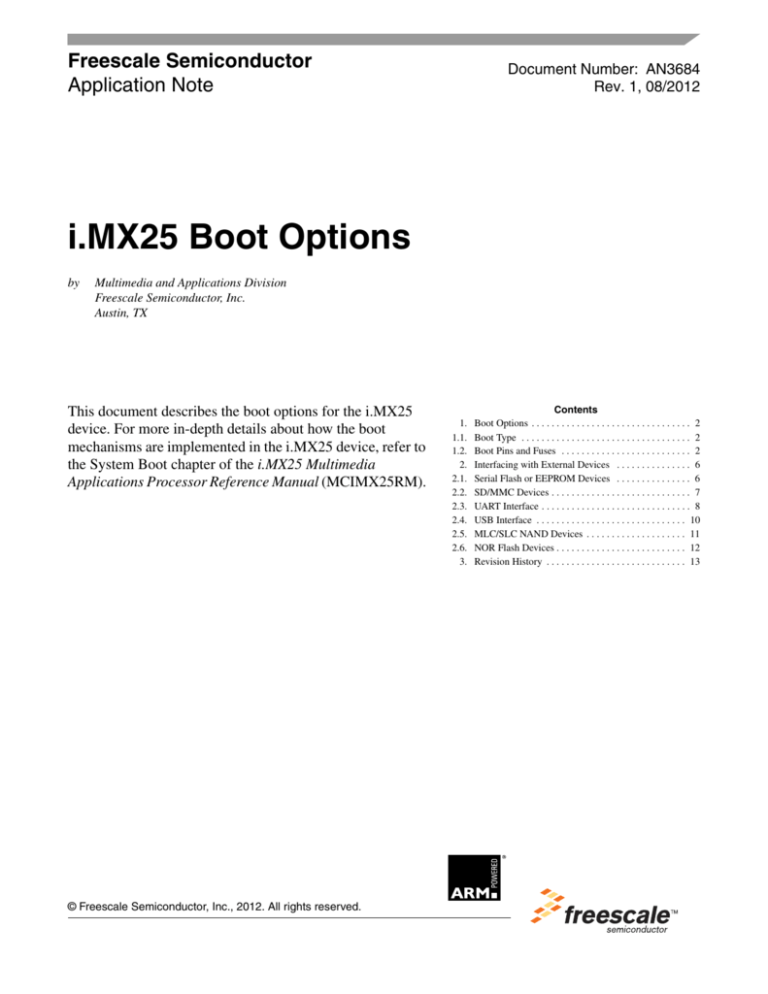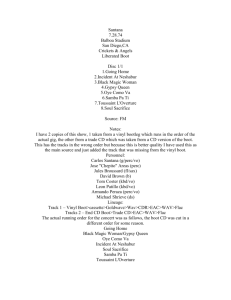
Freescale Semiconductor
Application Note
Document Number: AN3684
Rev. 1, 08/2012
i.MX25 Boot Options
by
Multimedia and Applications Division
Freescale Semiconductor, Inc.
Austin, TX
This document describes the boot options for the i.MX25
device. For more in-depth details about how the boot
mechanisms are implemented in the i.MX25 device, refer to
the System Boot chapter of the i.MX25 Multimedia
Applications Processor Reference Manual (MCIMX25RM).
© Freescale Semiconductor, Inc., 2012. All rights reserved.
1.
1.1.
1.2.
2.
2.1.
2.2.
2.3.
2.4.
2.5.
2.6.
3.
Contents
Boot Options . . . . . . . . . . . . . . . . . . . . . . . . . . . . . . . . 2
Boot Type . . . . . . . . . . . . . . . . . . . . . . . . . . . . . . . . . . 2
Boot Pins and Fuses . . . . . . . . . . . . . . . . . . . . . . . . . . 2
Interfacing with External Devices . . . . . . . . . . . . . . . 6
Serial Flash or EEPROM Devices . . . . . . . . . . . . . . . 6
SD/MMC Devices . . . . . . . . . . . . . . . . . . . . . . . . . . . . 7
UART Interface . . . . . . . . . . . . . . . . . . . . . . . . . . . . . . 8
USB Interface . . . . . . . . . . . . . . . . . . . . . . . . . . . . . . 10
MLC/SLC NAND Devices . . . . . . . . . . . . . . . . . . . . 11
NOR Flash Devices . . . . . . . . . . . . . . . . . . . . . . . . . . 12
Revision History . . . . . . . . . . . . . . . . . . . . . . . . . . . . 13
Boot Options
1
Boot Options
Since the i.MX25 device is designed for a wide variety of applications, it is expected to operate in a large
variety of configurations. In addition, the i.MX25 is a pin-reduced chip. Therefore I/O muxing is used
aggressively and configuration restrictions are critical. To mitigate possible conflicts on bootable ports, the
SD/MMC, CSPI, I2C, or UART ports can all be chosen for boot. This adds great flexibility in system
configuration.
1.1
Boot Type
The type of boot is chosen by the state of the Boot Mode pins (BOOT_MODE0 and BOOT_MODE1).
These pins should be configured on the system board with pull-up or pull-down resistors to enter into the
desired boot mode. The values of these pins are sampled during reset and after reset these pins can be
configured to work as GPIOs. The value of the BOOT_MODE pins is stored in the CCM Status Register
(RCSR) of the CCM. The possible boot type options are:
• Internal Boot (utilizing ROM code and HAB)
• FSL Test Mode (reserved for factory use)
• Eternal Boot (direct boot without much interaction from ROM and without HAB)
• USB/UART Bootloader (allows code to be downloaded via USB/UART ports)
Table 1 shows more details of the boot types.
Table 1. Boot Mode Summary
1
BMOD
[1:0]
Boot Type
00
Internal Boot
01
FSL Test Mode
10
External (Direct) Boot
11
USB/UART Boot
Loader
Boot Details
Executes ROM code, which handles boot from following sources:
• NOR Flash (via WEIM, 16-bit slow asynchronous mode for debugging purpose only)
• OneNAND
• CSPI (serial Flash, only on chip select #1) Or via I2C
• NAND Flash
• SD/MMC (including high-capacity MoviNAND boot through MMC interface)
• USB, UART boot (fallback option for all other modes when an error exception occurs)
This mode is reserved for device testing and is intended for factory use only
Direct boot via the interface, independent of boot ROM code
Load and execute code via serial devices:
• USB (Full-Speed, via integrated OTG PHY or external via the OTG interface1)
• UART
For typical application board usage, the internal PHY options is recommended. The use of external transceivers is not
recommended, and would reduce availability of contacts.
1.2
Boot Pins and Fuses
Additional boot configuration is provided with either programmable e-fuses or by other pin values sampled
during the reset sequence. The i.MX25 provides an option to sample the boot configuration with either the
boot pins or the fuses. Selecting between the two options is controlled with the value of the GPIO_BT_SEL
fuse (by default this fuse is left un-blown). In the case that GPIO_BT_SEL fuse is blown, all of the boot
i.MX25 Boot Options, Rev. 1
2
Freescale Semiconductor
Boot Options
options are configured with the associated boot fuses as detailed in Table 2. When GPIO_BT_SEL is left
un-blown (default), all of the boot options are determined by sampling the state of the dedicated boot pins
during reset. For detailed information on the i.MX25 fuses refer to the i.MX25 IC Identification Module
(IIM) Fusebox Application Note Application Note (AN3682). Table 2 lists all of the associated boot pins
along with their associated e-fuses.
Table 2. Fuses and Associated Contacts Used for Boot
BGA
Contact
Direction at
Boot
eFuse Name
W20
BMOD[1]
Input
N/A
V19
BMOD[0]
U6
VSYNC
Input
BT_UART_SRC[2]
U7
HSYNC
Input
BT_UART_SRC[1]
W3
LD15
Input
BT_UART_SRC[0]
V4
LD14
Input
BT_EEPROM_CFG
W4, V5
LD[13:12]
Input
BT_SRC[1:0]
Chooses specific eSDHC, CSPI, or I2C controller for booting
Y3
LD11
Input
BT_SPARE_SIZE
Specifies the size of spare bytes for 4 Kbyte page size NAND
flash devices
Y4
LD10
Input
BT_MLC_SEL
W5, V6
LD[9:8]
Input
BT_USB_SRC[1:0]
Y5, W6
LD[7:6]
Input
BT_BUS_WIDTH[1:0] Selects bus width for selected interface
V7, Y6
LD[5:4]
Input
BT_PAGE_SIZE[1:0] NAND Flash page size
U8, W7
LD[3:2]
Input
BT_MEM_TYPE[1:0] Boot Memory Type
V8, Y7
LD[1:0]
Input
BT_MEM_CTL[1:0]
Boot Memory Control Type (memory device)
W2
PWM
Input
BT_LPB_FREQ[2]
Low Power Boot (LPB) ARM Core Frequency
V3
OE_ACD
Input
BT_LPB_FREQ[1]
U5
LSCLK
Input
BT_LPB_FREQ[0]
H20
CSI_PIXCLK
—
BT_RES3
Reserved
H19
CSI_HSYNC
—
BT_RES2
Reserved
G20
CSI_VSYNC
—
BT_RES1
Reserved
H18
CSI_MCLK
—
BT_RES0
Reserved
T20
VSTBY_ACK
Output
N/A
Details
Boot Mode Type selection (See Table 1)
Selects which UART port is used as the bootable source
Selects if EEPROM device uses DCD
Selects if NAND is SLC or MLC device
Selects if using internal/external OTG PHY
Pulse indication on finish of internal system reset, by visibility
of hreset_b signal. After reset, this contact can be used for
other purposes.
Table 3 contains a more detailed listing of all of the available boot options and configurations.
i.MX25 Boot Options, Rev. 1
Freescale Semiconductor
3
Boot Options
Table 3. Fuse Descriptions
Fuse/GPIO
Definition
Settings
BT_SRC[1:0]
Chooses boot port eSDHC, CSPI or I2C.
Has a corresponding GPIO pin.
If BT_MEM_CTL[1:0] = 11 (Expansion card device) &
BT_MEM_TYPE[1:0] = 00
(SD/MMC/MoviNAND/CE-ATA) then
00 eSDHC1
01 eSDHC2
10 Reserved
11 Reserved
If BT_MEM_CTL[1:0] = 11 (Expansion card device) &
BT_MEM_TYPE[1:0] = 10 (Serial ROM via I2C) then
00 I2C1
01 I2C2
10 I2C3
11 Reserved
If BT_MEM_CTL[1:0] = 11 (Expansion card device) &
BT_MEM_TYPE[1:0] = 11 (Serial ROM via SPI) then
00 CSPI1
01 CSPI2
10 CSPI3
11 Reserved
Other Reserved
BT_UART_SRC[2:0]
Choosing the specific UART controller for
booting from.
000 UART1
001 UART2
010 UART3
011 UART4
100 UART5
Other Reserved
SLC/MLC NAND device.
Has a corresponding GPIO pin.
0 SLC NAND device
1 MLC NAND device
BT_MLC_SEL
BT_SPARE_SIZE
BT_USB_SRC[1:0]
Specifies the size of spare bytes for 4 Kbyte 0 128 bytes spare (Samsung) (4-bit ECC)
page size NAND Flash devices. Has a
1 218 bytes spare (Micron, Toshiba) (8-bit ECC)
corresponding GPIO pin.
Note: 512 byte page devices have 16 bytes
spare area size, 2 Kbyte page devices have
64 bytes spare area size.
Note: Assumes that the large spare area
devices (218 byte) use 8-bit ECC. Otherwise,
4-bit ECC.
USB boot source selection.
Has a corresponding GPIO pin.
BT_PAGE_SIZE[1:0] NAND Flash Page Size.
This field is used with conjunction with the
BT_MEM_CTL[1:0] setting.
Has a corresponding GPIO pin.
00
01
10
11
USB OTG Internal PHY
USB OTG External ULPI PHY
Reserved
Reserved
If BT_MEM_CTL = NAND Flash then
00 512 bytes
01 2 Kbytes
10 4 Kbytes
11 Reserved
i.MX25 Boot Options, Rev. 1
4
Freescale Semiconductor
Boot Options
Table 3. Fuse Descriptions (continued)
Fuse/GPIO
BT_EEPROM_CFG
Definition
Settings
Selects whether EEPROM device is used for 0 Use EEPROM DCD
load of configuration DCD data, prior to boot 1 Do not use EEPROM DCD
from other devices (not applicable when
using EEPROM as boot device).
Has a corresponding GPIO pin.
GPIO_BT_SEL
GPIO Boot Select.
Determines if certain boot fuse values are
controlled from GPIO pins or IIM
0 Boot mode configuration is taken from GPIOs
1 Boot mode configuration is taken from fuses
HAB_TYPE[2:0]
Security Type.
This fuse comes pre-programmed to
Engineering mode
001 Engineering (allows any code to be flashed and
executed, even if it has no valid signature)
100 Security Disabled (For internal/testing use)
Others Production (Security On)
BT_MEM_TYPE[1:0] Boot Memory Type.
Interpreted by boot ROM SW according to
BT_MEM_CTL setting. Signals could also be
interpreted by HW to alter delays and timing
in support of direct boot.
Has a corresponding GPIO pin.
If BT_MEM_CTL = WEIM then
00 NOR
01 Reserved
10 OneNand
11 Reserved
If BT_MEM_CTL = NAND Flash
00 3 address cycles
01 4 address cycles
10 5 address cycles
11 Reserved
If BT_MEM_CTL = Expansion Card Device
00 SD/MMC/MoviNAND/CE-ATA
01 Reserved
10 Serial ROM via I2C
11 Serial ROM via SPI
BT_BUS_WIDTH[1:0] Bus width and muxed/unmuxed interface.
Has a corresponding GPIO pin.
BT_MEM_CTL[1:0] = NAND Flash
00 8 bit bus
01 16 bit bus
10 Reserved
11 Reserved
BT_MEM_CTL[1:0] = WEIM (NOR)
00 Reserved
01 16 bit address/data unmuxed interface
10 Reserved
11 Reserved
BT_MEM_CTL[1:0] = Expansion Device (SPI)
00 2-Address word SPI device (16-bit)
01 3-Address word SPI device (24-bit)
10 Reserved
11 Reserved
i.MX25 Boot Options, Rev. 1
Freescale Semiconductor
5
Interfacing with External Devices
Table 3. Fuse Descriptions (continued)
Fuse/GPIO
BT_MEM_CTL[1:0]
DIR_BT_DIS
2
Definition
Settings
Boot Memory Control Type (memory device). 00 WEIM
01 NAND Flash
Has a corresponding GPIO pin.
10 Reserved
11 Expansion Device (SD/MMC/MoviNAND/CE-ATA,
I2C, SPI)
See BT_MEM_TYPE[1:0] settings for details
Direct External Memory Boot Disable
0 Direct boot from external memory is allowed
1 Direct boot from external memory is not allowed
Interfacing with External Devices
In addition to setting the boot mode or configuring the boot fuses, users also need to be concerned about
which IOMUX instance of each module is used for boot. Given that the i.MX25 uses an aggressive
IOMUX scheme, some modules can be muxed out of more than one location to add flexibility. However,
the boot ROM only utilizes a single location for each bootable module. The following sections provide
more detail as to which pins are used for each module during boot.
2.1
Serial Flash or EEPROM Devices
The i.MX25 can be booted from a serial ROM device such as SPI Flash or an EEPROM device using CSPI
or I2C. When using the CSPI ports, only slave select 1 (SS1) of each port is bootable. Also if using I2C,
the interface is configured at speed of 389.6 Kbps. Table 4 lists the boot settings which must be set in order
to boot from CSPI or I2C ports.
Table 4. CSPI/I2C Boot Configuration
Fuse/GPIO
Setting
Comment
BMOD[1:0]
00
Must be set for internal boot for boot ROM to be used
BT_MEM_CTL[1:0]
11
Set to Expansion which includes I2C and CSPI
BT_MEM_TYPE[1:0]
10 I2C
11 CSPI
Boot with I2C or CSPI
BT_SRC[1:0]
00 I2C1
01 I2C2
10 I2C3
If I2C is selected with BT_MEM_TYPE
BT_SRC[1:0]
00 CSPI1
01 CSPI2
10 CSPI3
If CSPI is selected with BT_MEM_TYPE
BT_BUS_WIDTH[1:0] Optional for SPI
BT_EEPROM_CFG
Optional for I2C
00 2-Address word SPI device (16-bit)
01 3-Address word SPI device (24-bit)
0 Uses EEPROM DCD
1 Does not use EEPROM DCD
i.MX25 Boot Options, Rev. 1
6
Freescale Semiconductor
Interfacing with External Devices
In addition to setting the boot mode pins, the pins to connect the external serial ROM device must be
selected. Table 5 lists which IOMUX options and pins are used for each configuration when using CSPI
or I2C ports.
Table 5. CSPI/I2C Boot Device IOMUX
Interface
Function
Pad Name
BGA
ALT
CSPI1
SCLK
CSPI1_SCLK
U3
ALT0
MOSI
CSPI1_MOSI
T4
ALT0
MISO
CSPI1_MISO
W1
ALT0
SS1
CSPI1_SS1
V2
ALT0
SCLK
SD1_DATA0
L20
ALT1
MOSI
SD1_CMD
K20
ALT1
MISO
SD1_CLK
M20
ALT1
SS1
SD1_DATA3
J20
ALT1
SCLK
CS1_D4
F19
ALT7
MOSI
CSI_D2
F18
ALT7
MISO
CSI_D3
E19
ALT7
SS1
CSI_D7
E18
ALT7
SCL
I2C1_CLK
F17
ALT0
SDA
I2C1_DAT
G17
ALT0
SCL
FEC_RDATA1
M4
ALT1
SDA
FEC_RX_DV
M3
ALT1
SCL
GPIO_E
P18
ALT1
SDA
CSPI1_SS1
V2
ALT1
CSPI2
CSPI3
I2C1
I2C2
I2C3
2.2
SD/MMC Devices
The i.MX25 can be booted from SD/MMC cards through either of the two eSDHC interfaces. The eSDHC
module supports high capacity SD, eSD (Embedded SD, version 2.1), MMC/eMMC (version 4.3),
CE-ATA, and other managed NAND devices such as MoviNAND (which are all SD interfaces). Table 6
lists the boot settings which must be set in order to boot from eSDHC ports.
Table 6. SD/MMC Boot Configuration
Fuse/GPIO
Setting
Comment
BMOD[1:0]
00
Must be set for internal boot for boot ROM to be used
BT_MEM_CTL[1:0]
11
Set to Expansion which includes eSDHC
BT_MEM_TYPE[1:0]
00
Sets to eSDHC type device
00 eSDHC1
01 eSDHC2
Selects between eSDCH1 and eSDHC2 ports
BT_SRC[1:0]
i.MX25 Boot Options, Rev. 1
Freescale Semiconductor
7
Interfacing with External Devices
In addition to setting the boot mode pins, the pins to connect the external SD/MMC device must be
selected. Table 7 lists which IOMUX options and pins are used for each configuration when using the
eSDHC1 or eSDCH2 ports. Although each eSDHC interface supports 8 bits of data, only a 1-bit interface
is enabled. It is up to the users boot code to configure the interface to 4 or 8 bits.
Table 7. SD/MMC Boot Device IOMUX
Interface
Function
Pad Name
BGA
ALT
eSDHC1
CLK
SD1_CLK
M20
ALT0
CMD
SD1_CMD
K20
ALT0
DAT0
SD1_DATA0
L20
ALT0
DAT1
SD1_DATA1
N20
ALT0
DAT2
SD1_DATA2
M19
ALT0
DAT3
SD1_DATA3
J20
ALT0
DAT4
UART2_CTS
R2
ALT1
DAT5
UART2_RTS
R3
ALT1
DAT6
UART2_TXD
T1
ALT1
DAT7
UART2_RXD
P4
ALT1
CLK
CSI_D7
E18
ALT2
CMD
CSI_D6
E20
ALT2
DAT0
CSI_MCLK
H18
ALT2
DAT1
CSI_VSYNC
G20
ALT2
DAT2
CSI_HSYNC
H19
ALT2
DAT3
CSI_PIXCLK
H20
ALT2
DAT4
CSI_D2
F18
ALT2
DAT5
CSI_D3
E19
ALT2
DAT6
CSI_D4
F19
ALT2
DAT7
CSI_D5
G18
ALT2
eSDCH2
2.3
UART Interface
The i.MX25 can be booted from any of the five UART ports on the i.MX25. When in serial boot mode, the
ROM polls both the UART and USB status registers for about 90 seconds. The port (USB or UART) which
shows activity first is selected as the active interface. If there is no activity within the pre-defined loop time,
the ROM resets the i.MX25 using the WDOG. In a valid boot session with USB or UART the WDOG is
serviced periodically to prevent unwanted reset of the i.MX25. Additionally, if communication between
the host and iMX25 hangs for more than 90 seconds or the i.MX25 goes into an endless loop, the WDOG
expires and reset the device. When using UART, the interface is configured with baud rate of 115.2 Kbps,
parity disabled, 1 stop bit, and 8-bit data length. Table 8 lists the boot settings which must be set in order
to boot from the UART ports
i.MX25 Boot Options, Rev. 1
8
Freescale Semiconductor
Interfacing with External Devices
Table 8. UART Boot Configuration
Fuse/GPIO
BMOD[1:0]
Setting
Comment
11
BT_UART_SRC[2:0] 000
001
010
011
100
Must be set for serial boot via UART or USB
UART1
UART2
UART3
UART4
UART5
Select which UART controller to boot from
In addition to setting the boot mode pins, the pins to connect the external UART device must be selected.
Table 9 lists which IOMUX option and pins are used for each configuration when using the UART ports.
Table 9. UART Boot Device IOMUX
Interface
Function
Pad Name
BGA
ALT
UART1
CTS
UART1_CTS
T2
ALT0
DCD
KPP_ROW2
P3
ALT4
DSR
KPP_ROW1
R1
ALT4
DTR
KPP_ROW0
N4
ALT4
RI
KPP_ROW3
P2
ALT4
RTS
UART1_RTS
T3
ALT0
RXD
UART1_RXD
U2
ALT0
TXD
UART1_TXD
U1
ALT0
CTS
UART2_CTS
R2
ALT0
DCD
UART1_RTS
T3
ALT3
DSR
UART1_TXD
U1
ALT3
DTR
UART1_RXD
U2
ALT3
RI
UART1_CTS
T2
ALT3
RTS
UART2_RTS
R3
ALT0
RXD
UART2_RXD
P4
ALT0
TXD
UART2_TXD
T1
ALT0
CTS
KPP_ROW3
P2
ALT1
RTS
KPP_ROW2
P3
ALT1
RXD
KPP_ROW0
N4
ALT1
TXD
KPP_ROW1
R1
ALT1
CTS
KPP_COL3
N1
ALT1
RTS
KPP_COL2
N2
ALT1
RXD
KPP_COL0
P1
ALT1
TXD
KPP_COL1
N3
ALT1
UART2
UART3
UART4
i.MX25 Boot Options, Rev. 1
Freescale Semiconductor
9
Interfacing with External Devices
Table 9. UART Boot Device IOMUX (continued)
2.4
Interface
Function
Pad Name
BGA
ALT
UART5
CTS
CSI_D5
G18
ALT1
RTS
CSI_D4
F19
ALT1
RXD
CSI_D2
F18
ALT1
TXD
CSI_D3
E19
ALT1
USB Interface
The i.MX25 device can be booted from the OTG USB port. When in serial boot mode, the ROM polls both
UART and USB status registers for about 90 seconds. The port (USB or UART) which shows activity first
is selected as the active interface. If there is no activity within the pre-defined loop time, the ROM resets
the i.MX25 using the WDOG. In a valid boot session with USB or UART the WDOG is serviced
periodically to prevent unwanted reset of the i.MX25. Additionally, if communication between the host
and i.MX25 hangs for more than 90 seconds or the i.MX25 goes into an endless loop, the WDOG expires
and reset the device. When using the USB OTG interface, the internal HS OTG PHY or an external PHY
using the OTG ULPI interface can be selected. Table 10 lists the boot settings which must be set in order
to boot from the USB OTG port.
Table 10. USB Boot Configuration
Fuse/GPIO
BMOD[1:0]
BT_USB_SRC[1:0]
Setting
Comment
11
Must be set for serial boot via UART or USB
00 Internal PHY
01 External PHY
Select OTG Internal HS PHY or select to use an External ULPI PHY
In addition to setting the boot mode pins, the pins to connect the external USB device must be selected.
Table 11 lists which IOMUX option and pins are used for each configuration when using the USB OTG
port.
i.MX25 Boot Options, Rev. 1
10
Freescale Semiconductor
Interfacing with External Devices
Table 11. USB Boot Device IOMUX
Interface
Function
Pad Name
BGA
ALT
USB OTG External ULPI PHY
USBOTG_OC
GPIO_B
N18
ALT2
USBOTG_DATA0
CSI_D2
F18
ALT6
USBOTG_DATA1
CSI_D3
E19
ALT6
USBOTG_DATA2
CSI_D4
F19
ALT6
USBOTG_DATA3
CSI_D5
G18
ALT6
USBOTG_DATA4
CSI_D6
E20
ALT6
USBOTG_DATA5
CSI_D7
E18
ALT6
USBOTG_DATA6
CSI_D8
G19
ALT6
USBOTG_DATA7
CSI_D9
F20
ALT6
USBOTG_DIR
CSI_MCLK
H18
ALT6
USBOTG_STP
CSI_VSYNC
G20
ALT6
USBOTG_NXT
CSI_HSYNC
H19
ALT6
USBOTG_CLK
CSI_PIXCLK
H20
ALT6
VBUS
USBPHY1_VBUS
K17
Dedicated
DP
USBPHY1_DP
L18
Dedicated
DM
USBPHY1_DM
K18
Dedicated
UID
USBPHY1_UID
J18
Dedicated
RREF
USBPHY1_RREF
L17
Dedicated
USB OTG Internal HS PHY
2.5
MLC/SLC NAND Devices
The i.MX25 can be booted from NAND Flash through the NFC interface. There is support for SLC and
MLC (512 bytes 4-bit ECC, 2 Kbyte 4-bit ECC and 4 Kbyte page sizes 4/8-bit ECC). Table 12 lists the
boot settings which must be set in order to boot from NAND ports.
Table 12. NAND Boot Configuration
Fuse/GPIO
BMOD[1:0]
BT_MEM_CTL[1:0]
Setting
Comment
00 Internal
10 External
Select internal boot which uses secure boot (requires an image header) or
external for direct boot from NAND
01
Set to boot from NAND Flash
BT_MEM_TYPE[1:0] 00 3 address cycles Sets the number of address cycles needed for the NAND
01 4 address cycles
10 5 address cycles
BT_MLC_SEL
0 SLC
1 MLC
Select SLC or MLC NAND
i.MX25 Boot Options, Rev. 1
Freescale Semiconductor
11
Interfacing with External Devices
Table 12. NAND Boot Configuration (continued)
Fuse/GPIO
BT_SPARE_SIZE
Setting
Comment
0 128 bytes
1 218 bytes
0 128 bytes spare (Samsung) (4-bit ECC)
1 218 bytes spare (Micron, Toshiba) (8-bit ECC)
BT_PAGE_SIZE[1:0] 00 512 bytes
01 2 Kbytes
10 4 Kbytes
Set the NAND Flash page size
BT_BUS_WIDTH[1:0] 00 8-bit bus
01 16-bit bus
Set the NAND bus width
In addition to setting the boot mode pins, the pins to connect the external NAND device must be selected.
Table 13 lists which IOMUX option and pins are used for the NFC interface.
Table 13. NAND Boot Device IOMUX
2.6
Interface
Function
Pad Name
BGA
ALT
NFC
NANDF_CE0
NF_CE0
D2
ALT0
NANDF_CLE
NFCLE
E4
ALT0
NANDF_ALE
NFALE
F4
ALT0
NANDF_WE_B
NFWE_B
G4
ALT0
NANDF_RE_B
NFRE_B
C1
ALT0
NANDF_WP_B
NFWP_B
H4
ALT0
NANDF_RB
NFRB
C2
ALT0
EIM_D[15:0]
D[15:0]
—
ALT0
NOR Flash Devices
The i.MX25 can be booted from NOR Flash or OneNAND through the WEIM interface. Table 14 lists the
boot settings which must be set in order to boot from the WEIM interface.
Table 14. NAND Boot Configuration
Fuse/GPIO
BMOD[1:0]
BT_MEM_CTL[1:0]
Setting
Comment
00 Internal
10 External
Select internal boot which uses secure boot or external for direct boot from WEIM
00
Set to boot from WEIM Interface
BT_MEM_TYPE[1:0] 00 NOR
10 OneNand
Set to boot with NOR or OneNand device
BT_BUS_WIDTH[1:0] 00 Reserved
00 Reserved
01 16-bit unmuxed 01 16 bit address/data unmuxed interface
In addition to setting the boot mode pins, the pins to connect the external NOR WEIM device must be
selected. Since WEIM is the default option of the i.MX25, the ROM code does not need to modify any
IOMUX settings and the boot is carried out on the EIM port.
i.MX25 Boot Options, Rev. 1
12
Freescale Semiconductor
Revision History
3
Revision History
Table 15 provides a revision history for this application note.
Table 15. Document Revision History
Rev.
Number
Date
Substantive Change(s)
1
08/2012
• In Table 3, "Fuse Descriptions," on page 4, replaced “16 bit address/data muxed
interface” with “Reserved.”
• In Table 14, "NAND Boot Configuration," on page 12, replaced “16 bit address/data
muxed interface” with “Reserved,” and “16-bit muxed” with “Reserved.”
0
06/2009
Initial release.
i.MX25 Boot Options, Rev. 1
Freescale Semiconductor
13
How to Reach Us:
Information in this document is provided solely to enable system and software
Home Page:
freescale.com
implementers to use Freescale products. There are no express or implied copyright
Web Support:
freescale.com/support
information in this document.
licenses granted hereunder to design or fabricate any integrated circuits based on the
Freescale reserves the right to make changes without further notice to any products
herein. Freescale makes no warranty, representation, or guarantee regarding the
suitability of its products for any particular purpose, nor does Freescale assume any
liability arising out of the application or use of any product or circuit, and specifically
disclaims any and all liability, including without limitation consequential or incidental
damages. “Typical” parameters that may be provided in Freescale data sheets and/or
specifications can and do vary in different applications, and actual performance may
vary over time. All operating parameters, including “typicals,” must be validated for each
customer application by customer’s technical experts. Freescale does not convey any
license under its patent rights nor the rights of others. Freescale sells products pursuant
to standard terms and conditions of sale, which can be found at the following address:
freescale.com/SalesTermsandConditions.
Freescale and the Freescale logo are trademarks of Freescale Semiconductor, Inc.,
Reg. U.S. Pat. & Tm. Off. All other product or service names are the property of their
respective owners. ARM is the registered trademark of ARM Limited.
© 2012 Freescale Semiconductor, Inc.
Document Number: AN3684
Rev. 1
08/2012









